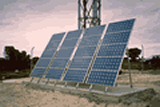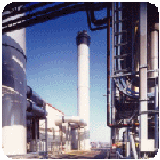Sustainable Buildings SPD
(4) 7. Renewable Energy Technologies
Photovoltaics (Solar Panels)
7.1 Solar Panels convert the sun’s energy into electricity which can be used to power the energy needs of a development. The panels are made of PV cells which consist of two layers of semi conducting material available as panels or tiles which can be mounted on the roof, ground or as cladding. They are most effective on a south facing roof surface but can be used at most locations providing there is no overshadowing by nearby buildings. Solar Panels are suitable for most types and sizes of development and are low maintenance once they have been installed. It is also possible to feed excess electricity back into the power grid. Careful consideration in terms of siting and design is needed in the case of listed buildings (see paragraphs 7.11 to 7.15).
Solar thermal systems
7.2 Solar collectors absorb the sun’s energy and use it to heat water which is transferred to a hot water cylinder to meet the needs of the building. Three types of collectors are available; unglazed plastic, flat plate and evacuated tube, the suitability of which depends on the location and type of development. This technology is most suitable for schemes which have a year round hot water demand.
Wind Energy
(2) 7.3 Turbines use energy from the wind to produce electricity. The capacity for utilising large scale wind turbines or wind farms within Warwick District is limited particularly within the urban areas. There may be potential for stand alone micro turbines where they can be mounted away from other buildings and where consideration is given to:
- any potential disturbance on neighbouring uses in terms of noise and vibration.
- the visual impact on the townscape (see paragraphs 7.16 to 7.18).
A new generation of vertical axis turbines is now available which is not dependant on wind direction.
Biomass Heating
(1) 7.4 Biomass boilers and stoves burn organic materials such as wood pellets or bio crops instead of traditional oil and gas. Boilers can be connected to central heating and hot water systems and stoves can be used to directly heat a room. The bio fuels must come from a sustainable source in order for it to be considered a renewable energy. It is most cost effective and sustainable when the supply of bio fuel is in close proximity and where there is adequate space to store the biomass on site.
Ground Source Heat Pumps
7.5 Underground pipes are used to absorb heat from the ground which is transferred to a heat distribution system which can provide heating as well as preheated domestic hot water. A large space is required for the pipes to be buried underground at a depth of around 1m however vertical heat exchangers (bore holes) may be used at a depth of 15 to 150 m where space is limited.
- Vertical heat exchangers are expensive and permission to drill boreholes may be required.
- There may be archaeological reasons which would make this technology unsuitable in certain locations
- Feasibility depends on the ground conditions
7.6 As underground temperatures remain fairly constant throughout the year and below peak temperatures in the summer, ground source pumps may also be used for cooling in offices and non domestic buildings.
Combined Heat and Power (CHP)
7.7 CHP units burn gas or oil to generate both heat and power and are therefore a much more efficient way of producing energy. CHP can provide significant carbon emission reductions however unless it is powered by bio fuel it is not considered to be a renewable technology. Where CHP is provided the Council may consider reducing the requirement for renewable energy. The Council will encourage schemes of 10 dwellings or 1000 sq m or more to consider the potential for CHP.
7.8 It is most suitable for large scale mixed use developments where there is a constant demand for heat and power. For example, a mixed development where offices would have a high energy demand during the day and residential units which would have a peak demand in the evening. Other uses which require a constant source of heat such as hotels (particularly those with a swimming pool) are particularly suited to this type of technology. There is potential for CHP to be connected to a wider district heating system.
7.9 Where CHP is proposed applicants will need to be clear who will be responsible for billing residents, the long term maintenance of the unit and the sourcing of fuel. This information should be set out in the energy statement.
7.10 More detailed guidance on the different types of renewable energy is available from the other sources listed in section 8.
Renewable Energy and the Historic Environment
(2) 7.11 The following paragraphs provide specific guidance on implementing renewable technologies in the historic environment.
Photovoltaics
(1) 7.12 The installation of solar panels can have a significant visual impact on the roof of a listed building or unlisted building in a conservation area which would detract from the historic integrity of the building. Careful consideration should therefore be given to locations that are not visible or are hidden from the main public view of the building. In certain instances there may not be a suitable location on the building itself and a free standing location in the garden of the property may be the best or only suitable location.
7.13 Photovoltaic tiles or slates may be used as a roof covering. In the case of listed buildings this may result in the removal of historic fabric that would be unacceptable. With unlisted buildings in conservation areas it may be possible to use this format on a rear or hidden roof slope. In certain cases with both listed and unlisted buildings this format may be appropriate on a contemporary extension where it is a designed element or on a garage, garden building or outbuilding physically detached from the main building.
Solar Thermal
7.14 Solar collectors are available in three basics types (see section 7) all of which are usually mounted as panels but can vary in appearance, for instance evacuated tubes will appear differently to a flat plate collector. All however can have a marked effect upon the appearance of an existing building that may detract from the quality of the building if it is listed or in a conservation area. Many roof coverings on traditional buildings are comprised of small scale elements that cannot readily accommodate the visual impact of large scale panel installations.
7.15 Wherever possible installations should be located on inner roof slopes or roof slopes that are not visible in the context of the important views of the building. In certain listed buildings it may not be possible to satisfactorily locate the collectors anywhere on the building itself without compromising its integrity. In such cases detached locations such as free standing locations in the garden with suitable screening or the use of roofs on outbuildings may be possible.
7.16 Several successful locations on listed building have included high level flat roofs and discrete locations behind parapets and or inner slopping roofs. A further consideration with historic buildings would be the effect upon the structure and the location of the thermal store inside the building.
Wind turbines
7.17 Wind turbines clearly need a certain height relative to their location to be effective and this means that they are particularly visible in any one location. In conservation areas and on listed buildings they can therefore be particularly intrusive and may significantly detract from the character of the area unless very sensitively located. There is also the need to ensure that a building is structurally capable of accommodating the turbine and the vibration that may be caused.
7.18 There may be locations at the rear of listed buildings and buildings in conservation areas where wind turbines can be located relatively unobtrusively, and these areas should always be investigated first when dealing with the historic environment. Detached locations may also be a means of accommodating a turbine in the historic environment for example within the ground or garden of the property, sometimes existing trees may act as a foil to the installation. With any detached location the need to seek approval for the excavation of a historic site may be necessary particularly if the site is a scheduled ancient monument.
7.19 Turbines with horizontal blades are available but less widely used than vertical blades. These may be less obtrusive and have less overall height
Biomass Boilers
7.20 The burning of biomass fuels in a historic building may have a similar function to the historic heat source in that building .The location of biomass boilers needs to take account of the impact on the historic fabric of the building and in the case of listed buildings may require listed building consent even if located entirely within the building. The location of any new flues will clearly also require listed building consent and may in some unlisted buildings in conservation areas require planning permission. Any new chimneys need to be sensitively located and constructed from traditional materials. Adequate storage buildings need to be provided for the fuel, these need to be sensitively designed and may also require separate consent. If the biomass fuel is to be grown on site the impact on the landscape particularly if it is a registered park or garden needs to be considered.
Ground Source Heat Pumps
7.21 Ground source heat pumps rely on either a system of pipes directly under a building or a single deep bore where space is restricted. These can be the least obtrusive form of renewable energy in the historic environment especially where a single deep bore can be accommodated. In listed buildings and scheduled ancient monuments care is needed not to disturb archaeology below the surface.
Combined Heat and Power
7.22 The impact on a historic building of using a combined heat and power system may be similar to biomass boilers where care needs to be taken in the location of the units internally and the location of any flues that may be needed.
General Advice
7.23 The use of any of the above systems may require either Listed Building Consent, or Planning Permission and/or Scheduled Monument Consent dependent on the location. Appropriate advice should always be sought. Each application will be determined on its merits and the precedent it may set for future location. It is recommended that an energy audit is carried out on any traditional property whether listed or in a conservation area to ascertain if the proposal is the most cost effective as well as the most visually appropriate for the location.




